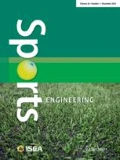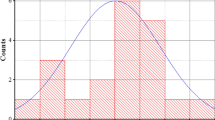Abstract
In road cycling, the pacing strategy plays an important role, especially in solo events like individual time trials. Nevertheless, not much is known about pacing under varying conditions. Based on mathematical models, optimal pacing strategies were derived for courses with varying slope or wind, but rarely tested for their practical validity. In this paper, we present a framework for feedback during rides in the field based on optimal pacing strategies and methods to update the strategy if conditions are different than expected in the optimal pacing strategy. To update the strategy, two solutions based on model predictive control and proportional–integral–derivative control, respectively, are presented. Real rides are simulated inducing perturbations like unexpected wind or errors in the model parameter estimates, e.g., rolling resistance. It is shown that the performance drops below the best achievable one taking into account the perturbations when the strategy is not updated. This is mainly due to premature exhaustion or unused energy resources at the end of the ride. Both the proposed strategy updates handle those problems and ensure that a performance close to the best under the given conditions is delivered.









Similar content being viewed by others
References
Clear J (2014) This coach improved every tiny thing by 1 percent and here’s what happened. https://jamesclear.com/marginal-gains. Accessed 09 Apr 2018
Abbiss CR, Laursen PB (2008) Describing and understanding pacing strategies during athletic competition. Sports Med 38(3):239
Swain DP (1997) A model for optimizing cycling performance by varying power on hills and in wind. Med Sci Sports Exerc 29(8):1104
Atkinson G, Peacock O, Passfield L (2007) Variable versus constant power strategies during cycling time-trials: prediction of time savings using an up-to-date mathematical model. J Sports Sci 25(9):1001
Cangley P, Passfield L, Carter H, Bailey M (2011) The effect of variable gradients on pacing in cycling time-trials. Int J Sports Med 32(02):132
Gordon S (2005) Optimising distribution of power during a cycling time trial. Sports Eng 8(2):81
Dahmen T, Wolf S, Saupe D (2012) Applications of mathematical models of road cycling. IFAC Proc Vol 45(2):804
Fayazi SA, Wan N, Lucich S, Vahidi A, Mocko G (2013) Optimal pacing in a cycling time-trial considering cyclist’s fatigue dynamics. In: American control conference (ACC), pp 6442–6447. IEEE, New York
Sundström D, Carlsson P, Tinnsten M (2014) Comparing bioenergetic models for the optimisation of pacing strategy in road cycling. Sports Eng 17(4):207
Dahmen T (2016) A 4-parameter critical power model for optimal pacing strategies in road cycling. In: Workshop modelling in endurance sports, pp 07–10
Sundström D, Bäckström M (2017) Optimization of pacing strategies for variable wind conditions in road cycling (Proceedings of the Institution of Mechanical Engineers). J Sports Eng Technol Part P 231(3):184
Yamamoto S (2018) Optimal pacing in road cycling using a nonlinear power constraint. Sports Eng
Wolf S, Bertschinger R, Saupe D (2016) Road cycling climbs made speedier by personalized pacing strategies. In: 4th international congress on sport sciences research and technology support, pp 109–114
Wan N, Fayazi SA, Saeidi H, Vahidi A (2014) Optimal power management of an electric bicycle based on terrain preview and considering human fatigue dynamics. In: American control conference (ACC), pp 3462–3467. IEEE, New York
Guanetti J, Formentin S, Corno M, Savaresi SM (2017) Optimal energy management in series hybrid electric bicycles. Automatica 81:96
Martin JC, Milliken DL, Cobb JE, McFadden KL, Coggan AR (1998) Validation of a mathematical model for road cycling power. J Appl Biomech 14(3):276
Dahmen T, Byshko R, Saupe D, Röder M, Mantler S (2011) Validation of a model and a simulator for road cycling on real tracks. Sports Eng 14(2–4):95
Monod H, Scherrer J (1965) The work capacity of a synergic muscular group. Ergonomics 8(3):329
Rieck M, Bittner M, Grüter B, Diepolder J (2017) Falcon.m user guide. http://www.falcon-m.com. Accessed 24 Oct 2017
Patterson MA, Rao AV (2014) GPOPS-II: a matlab software for solving multiple-phase optimal control problems using hp-adaptive Gaussian quadrature collocation methods and sparse nonlinear programming. ACM Trans Math Softw (TOMS) 41(1):1
Acado toolkit user’s manual v1.2.1beta (2017). http://acado.sourceforge.net/doc/pdf/acado_manual.pdf. Accessed 02 Nov 2017
Wolf S, Dobiasch M, Artiga Gonzalez A, Saupe D (2017) How to accurately determine the position on a known course in road cycling. In: International symposium on computer science in sport. Springer, New York, pp 103–109
Wolf S, Saupe D (2018) Knowing your slope on the track: getting the most out of GPS and power data. J Sci Cycl 6(3):14
Sundström D (2016) On a bioenergetic four-compartment model for human exercise. Sports Eng 19(4):251
Artiga Gonzalez A, Wolf S, Saupe D, Bertschinger R (2018) Visual feedback for pacing strategies in road cycling. In: Schriften der Deutschen Vereinigung für Sportwissenschaft, pp 76–77
Wolf S, Artiga Gonzalez A, Saupe D (2018) Modeling in road cycling for optimal pacing strategies: theory vs. practice. J Sci Cycl 7(2):18
Author information
Authors and Affiliations
Corresponding author
Additional information
Publisher’s Note
Springer Nature remains neutral with regard to jurisdictional claims in published maps and institutional affiliations.
This article is a part of Topical Collection in Sports Engineering on Measuring Behavior in Sport and Exercise, edited by Dr. Tom Allen, Dr. Robyn Grant, Dr. Stefan Mohr and Dr. Jonathan Shepherd.
This research was funded by the Deutsche Forschungsgemeinschaft (DFG, German Research Foundation)—247721022.
Rights and permissions
About this article
Cite this article
Wolf, S., Biral, F. & Saupe, D. Adaptive feedback system for optimal pacing strategies in road cycling. Sports Eng 22, 6 (2019). https://doi.org/10.1007/s12283-019-0294-5
Published:
DOI: https://doi.org/10.1007/s12283-019-0294-5



